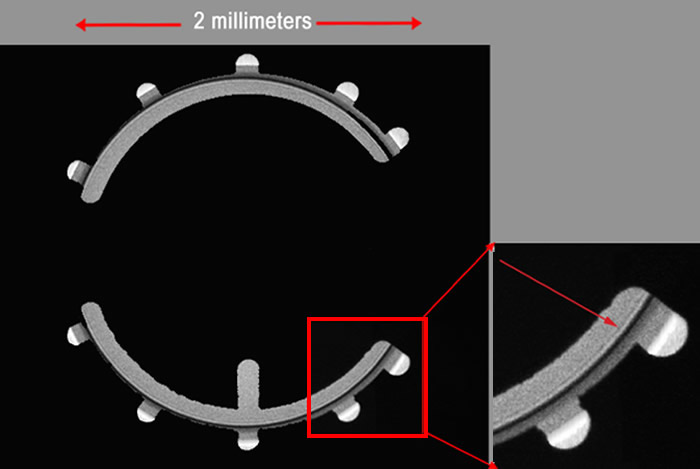Science & Technology - 2018
November
Thin Ice: Shrinking Frozen Target Capsule Fuel Layers
LLNL Target Fabrication scientists have found a way to make an already hair-thin layer of frozen inertial confinement fusion fuel even slimmer.
A focused effort achieved a cryogenically frozen deuterium-tritium (DT) fuel layer about 20 microns thick, much thinner than the typical layer of about 70 microns used in NIF experiments (see “How NIF Targets Work”). To put that in perspective, a strand of human hair can be 60 to 120 microns in diameter.
The latest milestone can help NIF researchers try to answer some of the ongoing questions about what happens during each nanosecond of target capsule implosion, including how much the inner part of the capsule mixes with the ice layer, said Target Fabrication Science and Technology Leader Suhas Bhandarkar.
“This could give the NIF team a new learning tool that can be incorporated into the roadmap for getting ignition,” Bhandarkar said.
 This x-ray image, a cross-sectional look at a NIF fuel capsule seen through a cut-out of the hohlraum, shows the 20-micron DT ice layer. The dark line is the spherical capsule shell. The inset shows the ice layer, a faint dark line just above the capsule shell. The wider, slightly jagged grey band above the layer is DT vapor. Credit: Ignition Target Proofing Station data
This x-ray image, a cross-sectional look at a NIF fuel capsule seen through a cut-out of the hohlraum, shows the 20-micron DT ice layer. The dark line is the spherical capsule shell. The inset shows the ice layer, a faint dark line just above the capsule shell. The wider, slightly jagged grey band above the layer is DT vapor. Credit: Ignition Target Proofing Station data NIF experiments send 192 laser beams into a hohlraum holding the ablation target, a tiny spherical capsule with the cryogenically frozen DT fuel layered on the inside. The lasers create an x-ray bath that ends up triggering those hydrogen atoms to compress into an energy-generating hot spot.
Cryogenically chilling the fuel to just below the freezing point of hydrogen changes its phase from a gas to a liquid and then to a solid, which enhances the fuel’s density to the levels needed for achieving ignition. This cooling process, however—done at NIF just before the shot—is already a demanding task.
NIF physicists added an additional challenge to help with future experiments: They wanted to explore the interface of the ablator and the fuel when using much thinner ice layers.
Jim Sater, a physicist in the Target Fabrication Layering Group, and engineer Andrew Wray led the effort to overcome several obstacles before they could demonstrate the feasibility of slimming the ice layer to 20 microns. For example, the skinnier solid DT layer had to remain as perfectly smooth and free of defects as possible, even at minus-426 degrees Fahrenheit.
“That’s challenging because Mother Nature doesn’t allow you to do that very easily,” Bhandarkar said.
 Andrew Wray (left) and Jim Sater at the Ignition Target Proofing Station, which they used to cryogenically test the 20-micron fuel layer before sending it to NIF. Credit: Mark Meamber
Andrew Wray (left) and Jim Sater at the Ignition Target Proofing Station, which they used to cryogenically test the 20-micron fuel layer before sending it to NIF. Credit: Mark Meamber The team also had to ensure they could keep a precise inventory of fuel. They controlled the amount with what they called a “heat switch valve,” a tiny frozen plug of the fuel in the fill tube used to lock in the exact amount and mixture of fuel.
“We would melt that plug if we wanted fuel to go in or out, and once it was done, then we’d freeze it and plug the fill tube,” Bhandarkar said.
Another challenge was ensuring scientists could use x rays to distinguish the shape and integrity of the ice layer from the capsule’s inner surface. There are physical limits to how much thinner the layer can get before it’s indistinguishable from the capsule surface.
“The ultimate limit depends on measurement capabilities,” Sater said.
The 20-micron layer will likely be used in NIF shots next summer, but the team isn’t stopping there.
“In the long run, our goal is to push the limits and see if we can get this as thin as possible,” Bhandarkar said.
—Benny Evangelista
Follow us on Twitter: @lasers_llnl



